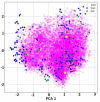Drugs Repurposing Using QSAR, Docking and Molecular Dynamics for Possible Inhibitors of the SARS-CoV-2 Mpro Protease
- PMID: 33172092
- PMCID: PMC7664330
- DOI: 10.3390/molecules25215172
Drugs Repurposing Using QSAR, Docking and Molecular Dynamics for Possible Inhibitors of the SARS-CoV-2 Mpro Protease
Abstract
Wuhan, China was the epicenter of the first zoonotic transmission of the severe acute respiratory syndrome coronavirus clade 2 (SARS-CoV-2) in December 2019 and it is the causative agent of the novel human coronavirus disease 2019 (COVID-19). Almost from the beginning of the COVID-19 outbreak several attempts were made to predict possible drugs capable of inhibiting the virus replication. In the present work a drug repurposing study is performed to identify potential SARS-CoV-2 protease inhibitors. We created a Quantitative Structure-Activity Relationship (QSAR) model based on a machine learning strategy using hundreds of inhibitor molecules of the main protease (Mpro) of the SARS-CoV coronavirus. The QSAR model was used for virtual screening of a large list of drugs from the DrugBank database. The best 20 candidates were then evaluated in-silico against the Mpro of SARS-CoV-2 by using docking and molecular dynamics analyses. Docking was done by using the Gold software, and the free energies of binding were predicted with the MM-PBSA method as implemented in AMBER. Our results indicate that levothyroxine, amobarbital and ABP-700 are the best potential inhibitors of the SARS-CoV-2 virus through their binding to the Mpro enzyme. Five other compounds showed also a negative but small free energy of binding: nikethamide, nifurtimox, rebimastat, apomine and rebastinib.
Keywords: COVID-19; QSAR; SARS-CoV-2; drugs repurposing; molecular dynamics.
Conflict of interest statement
The authors declare no conflict of interest.
Figures




Similar articles
-
Targeting SARS-CoV-2 Main Protease: A Computational Drug Repurposing Study.Arch Med Res. 2021 Jan;52(1):38-47. doi: 10.1016/j.arcmed.2020.09.013. Epub 2020 Sep 17. Arch Med Res. 2021. PMID: 32962867 Free PMC article.
-
Repurposing FDA-approved drugs for COVID-19: targeting the main protease through multi-phase in silico approach.Antivir Ther. 2024 Dec;29(6):13596535241305536. doi: 10.1177/13596535241305536. Antivir Ther. 2024. PMID: 39639531
-
Computational Screening Using a Combination of Ligand-Based Machine Learning and Molecular Docking Methods for the Repurposing of Antivirals Targeting the SARS-CoV-2 Main Protease.Daru. 2024 Jun;32(1):47-65. doi: 10.1007/s40199-023-00484-w. Epub 2023 Oct 31. Daru. 2024. PMID: 37907683 Free PMC article.
-
SARS-CoV-2 Mpro: A Potential Target for Peptidomimetics and Small-Molecule Inhibitors.Biomolecules. 2021 Apr 19;11(4):607. doi: 10.3390/biom11040607. Biomolecules. 2021. PMID: 33921886 Free PMC article. Review.
-
AI-driven covalent drug design strategies targeting main protease (mpro) against SARS-CoV-2: structural insights and molecular mechanisms.J Biomol Struct Dyn. 2025 Jul;43(11):5436-5464. doi: 10.1080/07391102.2024.2308769. Epub 2024 Jan 29. J Biomol Struct Dyn. 2025. PMID: 38287509 Review.
Cited by
-
3D-ALMOND-QSAR Models to Predict the Antidepressant Effect of Some Natural Compounds.Pharmaceutics. 2021 Sep 10;13(9):1449. doi: 10.3390/pharmaceutics13091449. Pharmaceutics. 2021. PMID: 34575524 Free PMC article.
-
Computational modeling predicts potential effects of the herbal infusion "horchata" against COVID-19.Food Chem. 2022 Jan 1;366:130589. doi: 10.1016/j.foodchem.2021.130589. Epub 2021 Jul 14. Food Chem. 2022. PMID: 34311241 Free PMC article.
-
Recent advances in chemometric modelling of inhibitors against SARS-CoV-2.Heliyon. 2024 Jan 9;10(2):e24209. doi: 10.1016/j.heliyon.2024.e24209. eCollection 2024 Jan 30. Heliyon. 2024. PMID: 38293468 Free PMC article. Review.
-
Sterenin M as a potential inhibitor of SARS-CoV-2 main protease identified from MeFSAT database using molecular docking, molecular dynamics simulation and binding free energy calculation.Comput Biol Med. 2021 Aug;135:104568. doi: 10.1016/j.compbiomed.2021.104568. Epub 2021 Jun 12. Comput Biol Med. 2021. PMID: 34174757 Free PMC article.
-
Tackling Immune Pathogenesis of COVID-19 through Molecular Pharmaceutics.Pharmaceutics. 2021 Apr 5;13(4):494. doi: 10.3390/pharmaceutics13040494. Pharmaceutics. 2021. PMID: 33916409 Free PMC article.
References
-
- López-Cortés A., Guevara-Ramírez P., Kyriakidis N.C., Barba-Ostria C., Cáceres Á.L., Guerrero S., Munteanu C.R., Tejera E., Ortiz-Prado E., Cevallos-Robalino D., et al. In Silico Analyses of Immune System Protein Interactome Network, Single-Cell RNA Sequencing of Human Tissues, and Artificial Neural Networks Reveal Potential Therapeutic Targets for Drug Repurposing Against COVID-19. ChemRxiv. 2020 doi: 10.26434/CHEMRXIV.12408074.V1. - DOI - PMC - PubMed
MeSH terms
Substances
LinkOut - more resources
Full Text Sources
Miscellaneous

